Diversity and Equity
Using Open-World Games to Support Inclusive Approaches to Computational Thinking
Connected Science Learning February–March 2023 (Volume 5, Issue 1)
By Dorothy Bennett, Cornelia Brunner, Nicholas Hartmann, and Stephen Uzzo
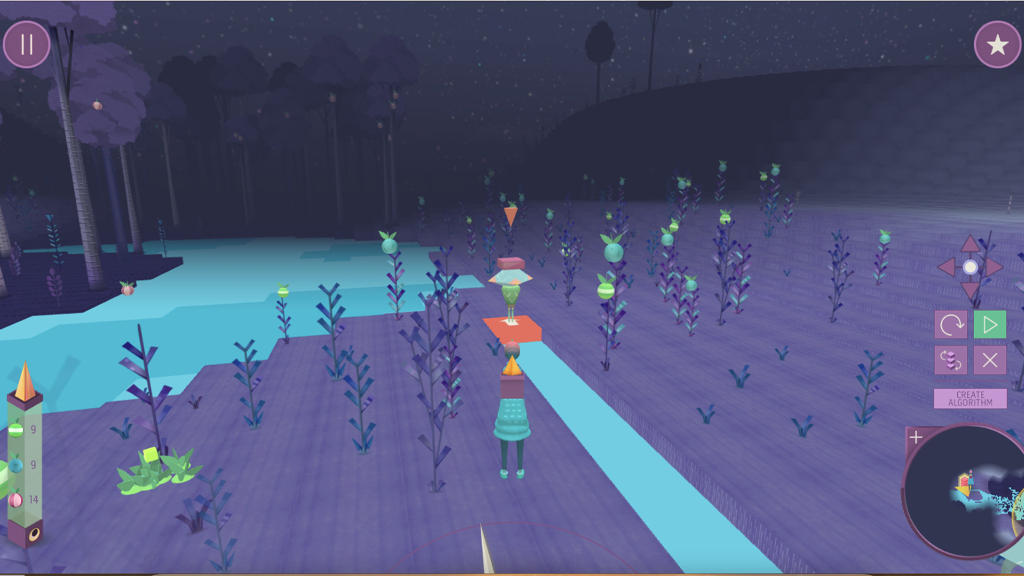
Over the past 10 years, national initiatives like CSforALL, policy makers, and funders have invested heavily in establishing computer science (CS) and computational thinking (CT) as fundamental components of U.S. K–12 STEM education (Code Advocacy Coalition/CSTA 2018). Computational thinking involves habits of mind that support the use of computational tools and practices to define and solve problems—skills that are fundamental to computer science careers (Weintrop et al. 2016). CT is also foundational to most STEM disciplines and essential for young people to navigate a world increasingly mediated by digital tools and machine learning, as it expands learners’ capacities to iteratively develop and test solutions to complex scientific and societal problems (Shute et al. 2017).
Despite the importance of CT, broader participation in computer science courses and majors that teach CT concepts and practices has remained low, particularly for young women and BIPOC learners (National Science Board and National Science Foundation 2022). In part, this is because CS education has often focused narrowly on coding and mastering procedural knowledge and the technology itself, rather than developing learners’ computational habits of mind and their capabilities for defining and solving problems that are personally and socially meaningful (Madkins et al. 2019).
Playing digital games provides inviting, alternative entry points into developing foundational CT skills without the traditional bottleneck of first learning how to code. Games help students engage in computational habits of mind by allowing learners to solve problems in more than one way, learn from failure in a low-stakes environment that encourages experimentation and iteration, and decipher the rules of a system as well as the sequence of actions that are needed to accomplish goals in the game world (Berland and Duncan 2016; Kazimoglu et al. 2012). This is particularly true of open-world games where learners have the autonomy to approach the game’s objectives freely, choosing the order and manner in which they address challenges within the constraints of the virtual world (e.g., see the University of Wisconsin–Madison’s Rainbow Agents game where learners develop CT skills by setting up a virtual community garden). More educators are turning to digital games to support students in developing CT skills; however, limited practical guidance exists on how to support mastery of specific CT concepts and skills or how to scaffold gameplay so it provides a more inclusive approach to learning CT, especially for learners who have been historically marginalized in CS courses and careers or who have varying levels of interest and experience in using computational tools.
In this article, we describe how shifting focus from coding to problem solving using emotional and imaginative imagery within a CT digital game can open up CT to a diverse range of elementary and middle school students. Drawing on formative work with teachers, children, and families from underserved communities during the pandemic’s challenging period of school closures and remote instruction, we offer insights and practical strategies for how educators can scaffold gameplay to support CT.
About the Pack Open-World Game to Support Computational Thinking
The New York Hall of Science (NYSCI), a hands-on science museum in Queens, New York, has been addressing this issue by creating resources to help teachers use the Pack, a digital computational thinking game for STEM instruction freely available to download. Museum staff developed the Pack game in collaboration with New York City teachers and interactive designers at Design I/O to create an open-world game environment that enables learners to actively use CT to address issues of ecological sustainability in a playful way.
The game is set in the fictional world of Algos, where ecosystems are faltering and players try to restore the environment by collecting seeds hidden in different types of biomes. On average, students take three to four hours to complete all seven game levels by embarking on a quest via their avatar to unlock new biomes and restore Algos to prosperity with the help of a “pack” of creatures they meet along the way.
The Pack’s core game mechanic (i.e., rules that govern and guide the player's actions) requires players to befriend, feed, and manage evolving “packs” of appealing, non-threatening creatures with specific functions such as dig, move, repeat, grab, seek, and bump. The player assembles different creatures into appropriate sequences or “algorithms” to help navigate difficult terrains, gather resources such as food and seeds, and alter the environment so the player and its inhabitants can thrive. This mechanic puts players in direct control over the computational “grammar” (the creatures) without relying on the vocabulary and notational procedures of coding, which helps students attach affective meaning to the computational procedures they use within the game world and provides a playful, conceptually rich point of reference for classroom discussion. This differentiates the Pack from other tools like Scratch, which focuses more explicitly on mastering coding. In this way, the Pack provides a low-barrier invitation into CT for young people who may not be intrinsically interested in coding for its own sake (Harteveld et al. 2014).
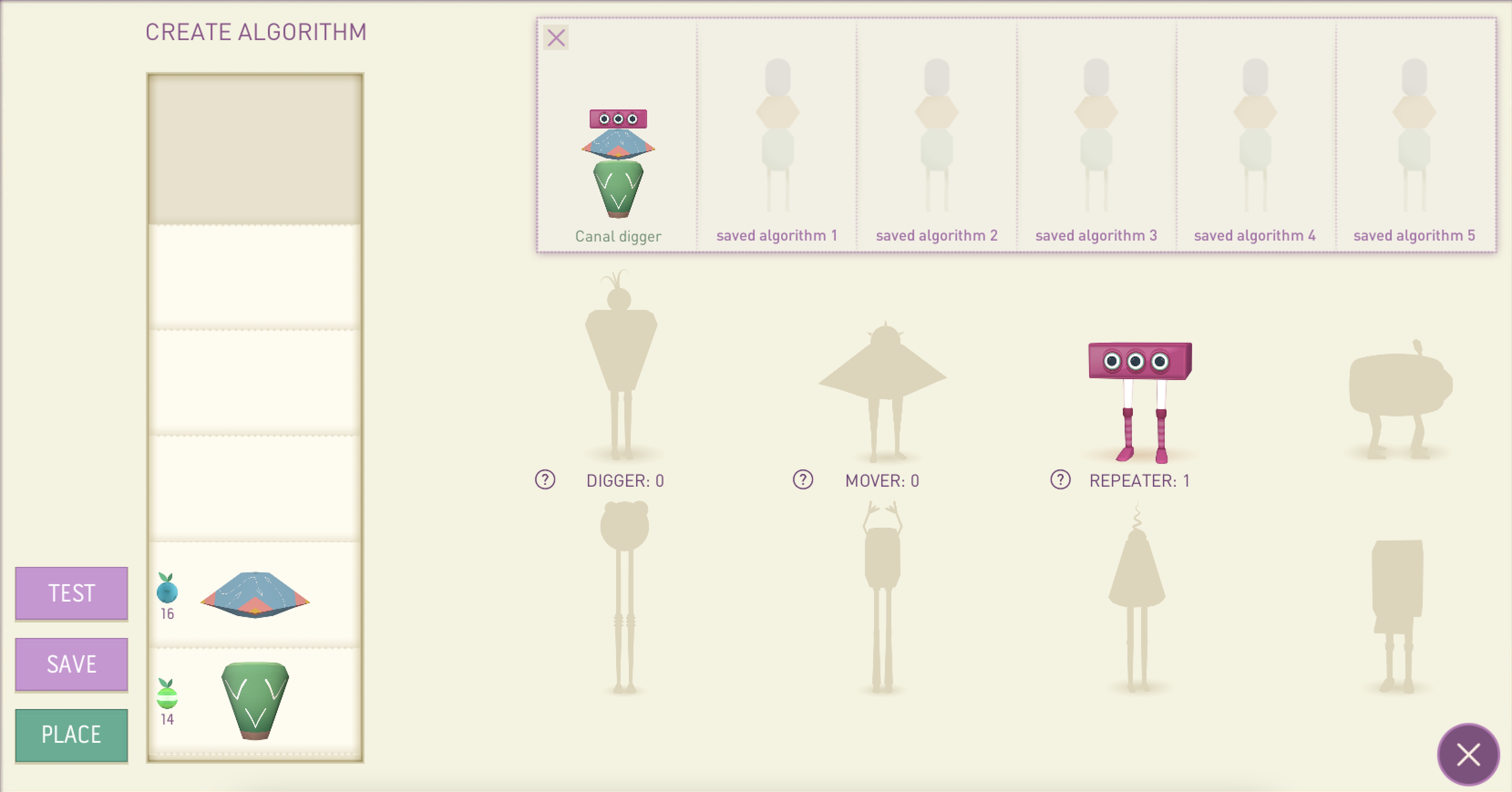
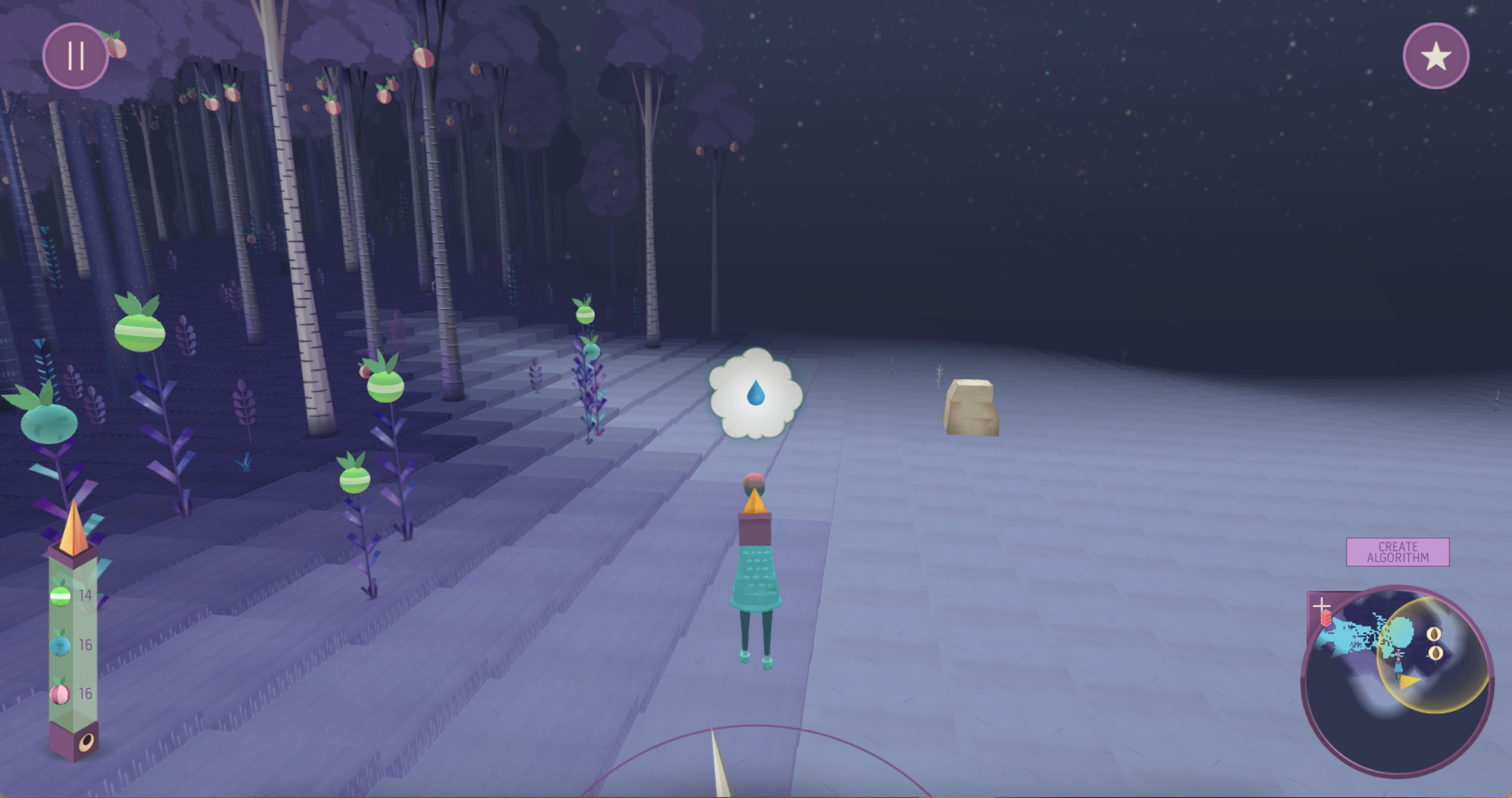
The Pack Program and Study
As part of a four-year study, NYSCI educators and program developers collaborated with evaluators from the American Institutes for Research (AIR); Participate, an online professional development organization; and New York City public school educators to develop and test supplemental curricular activities and professional development offerings that leverage the unique learning opportunities the game provides for engaging with CT. The Pack game supports three-dimensional learning espoused by the Next Generation Science Standards (NGSS). There is not a single right way to solve problems in the game, which encourages engagement with science and engineering practices (e.g., defining problems in which learners identify variables and parameters of the problem they are solving) and the application of crosscutting concepts (e.g., attending to cause and effect as they implement algorithms to address problems they confront in the world of Algos).
In the first three years of the project, we worked collaboratively with elementary and middle school STEM teachers and students to iteratively develop teaching resources focused on supporting foundational, standards-based CT concepts and practices outlined by recent computer science and digital literacy standards, such as decomposition, pattern recognition, abstraction, algorithms, and debugging (see Table 1 for these concepts and associated gameplay).
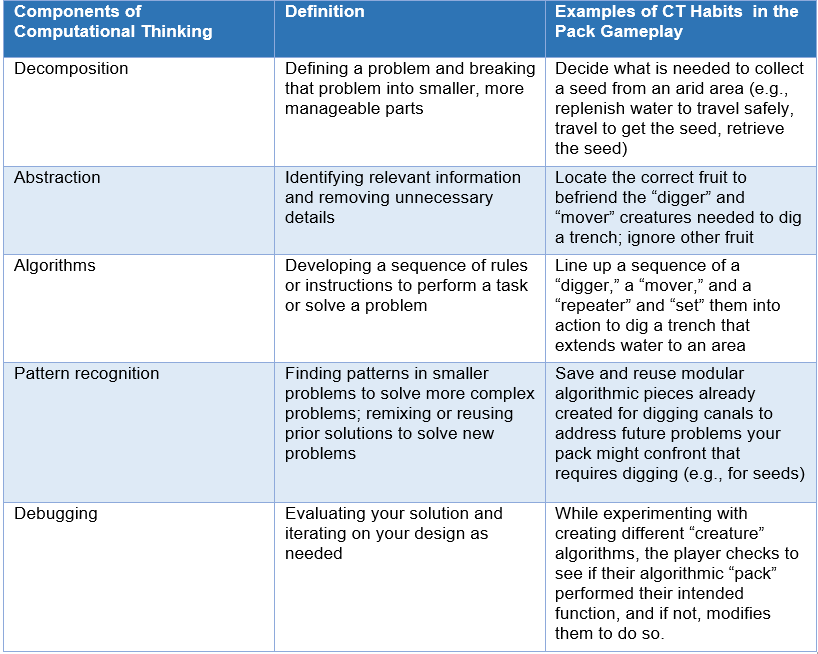
The resulting supplemental curriculum includes activities and tools that encourage fifth- through eighth-grade students to use the lens of CT to reflect on their decision-making processes throughout gameplay and to explore how solving problems in the game connects to solving problems in STEM classes and beyond. Tools include gameplay journals; dilemma worksheets where students share and compare steps to address gameplay scenarios; and mini-challenges where students apply specific CT practices in the game, such as debugging a creature algorithm that doesn’t work as anticipated. An accompanying teacher guide and online community of practice provide talking points, facilitation tips, and supports for differentiation, all aiming to help educators lead students through reflective debrief conversations and activities.
About the Project (Methods and Context)
Over a three-year period, museum educators and program developers designed a set of teacher supports through the following three phases of formative work conducted in collaboration with students, teachers, and families:
- Co-design with fifth- through eighth-grade science and technology teachers. A team of over 20 educators explored what CT might involve for this age group and how students’ use of CT might be supported via gameplay with the Pack and supporting CT supplemental resources (described above).
- Implementation of the Pack program in classrooms. Half of these teachers introduced the Pack game to their students and provided feedback on their use of the Pack, their perceived value of the game for supporting CT and other skills, and the successes and challenges they encountered in integrating the game into instruction.
- Testing the Pack in informal settings. We recruited 15 virtual game testers and 110 museum goers ages 9–14 to play the game to study how learners organically engage in CT through gameplay. This feedback provided practical insights into how learners interpreted the game without instruction, what motivates them to play, and how they navigate and engage with problem scenarios within the game.
Currently, 20 NYC middle school science and CS teachers have been recruited to integrate the Pack into their instruction for a more formal implementation study that will assess the impacts the Pack has on students’ attitudes toward CS and their mastery of CT practices and concepts. Drawing on feedback gathered through gameplay interviews, journals, and focus groups during the three years of formative work, below we describe how CT naturally emerges through different kinds of gameplay and offer practical strategies for how teachers can approach using games to support CT among their students.
Computational Thinking Exhibited Through Different Forms of Gameplay
The Pack game was designed for all types of learners, especially those who are demotivated by more traditional approaches to CT/CS exploration. The game supports different styles of play while offering opportunities for students to engage in CT through a finite set of shared problems that can be solved in multiple ways. The Pack offers a peaceful, non-pressured environment with plenty of needs to consider and opportunities to be clever–—without enemies or fights. While gameplay could become competitive if external criteria are applied to the evaluation of algorithms players create, the game world itself rewards players for getting things done and finding ways to solve problems, not the particular way tasks are done.
To inform how teachers could leverage students’ gameplay to foster CT, we wanted to distinguish, from a pedagogical perspective, how CT practices might be supported through the varied forms of gameplay in an open-world game. We developed activities and gameplay journals that encouraged students to reflect on their decision-making processes and conducted gameplay interviews to characterize how different learners played the game and applied CT in ways that may not be readily recognizable to teachers.
Overall, students exhibited three approaches to gameplay that mirror typologies of play identified by existing gameplay research (Nacke et al. 2014): Wanderers, Builders, and Coders. They also exhibited a broad range of CT skills and practices throughout these different play approaches, even when they played a limited amount (i.e., only getting through level 2). Through our work with middle school teachers, however, we learned it wasn’t always obvious to educators when CT was being applied across different types of gameplay, leading to missed opportunities for engaging all students more deeply with the CT. For example, we found that Wanderer play (free exploration) was more strongly preferred by female students over other gameplay approaches, but educators were less inclined to notice and build on the CT that emerged through this type of explorative play. To illustrate how CT can occur through diverse gameplay approaches, we provide profiles of the three dominant gameplay approaches observed and offer cases of how one foundational concept of CT—decomposition—was evidenced in these different play approaches.
The Wanderer Approach to Play
The Wanderer approach involves the player exploring all aspects of the environment to discover what the different biomes hold. These players are motivated to find the different creatures, fruits, and seeds available, regardless of the location. Wanderers explore high mountain tops, walk underwater, and use the map to find different locations they haven’t visited.
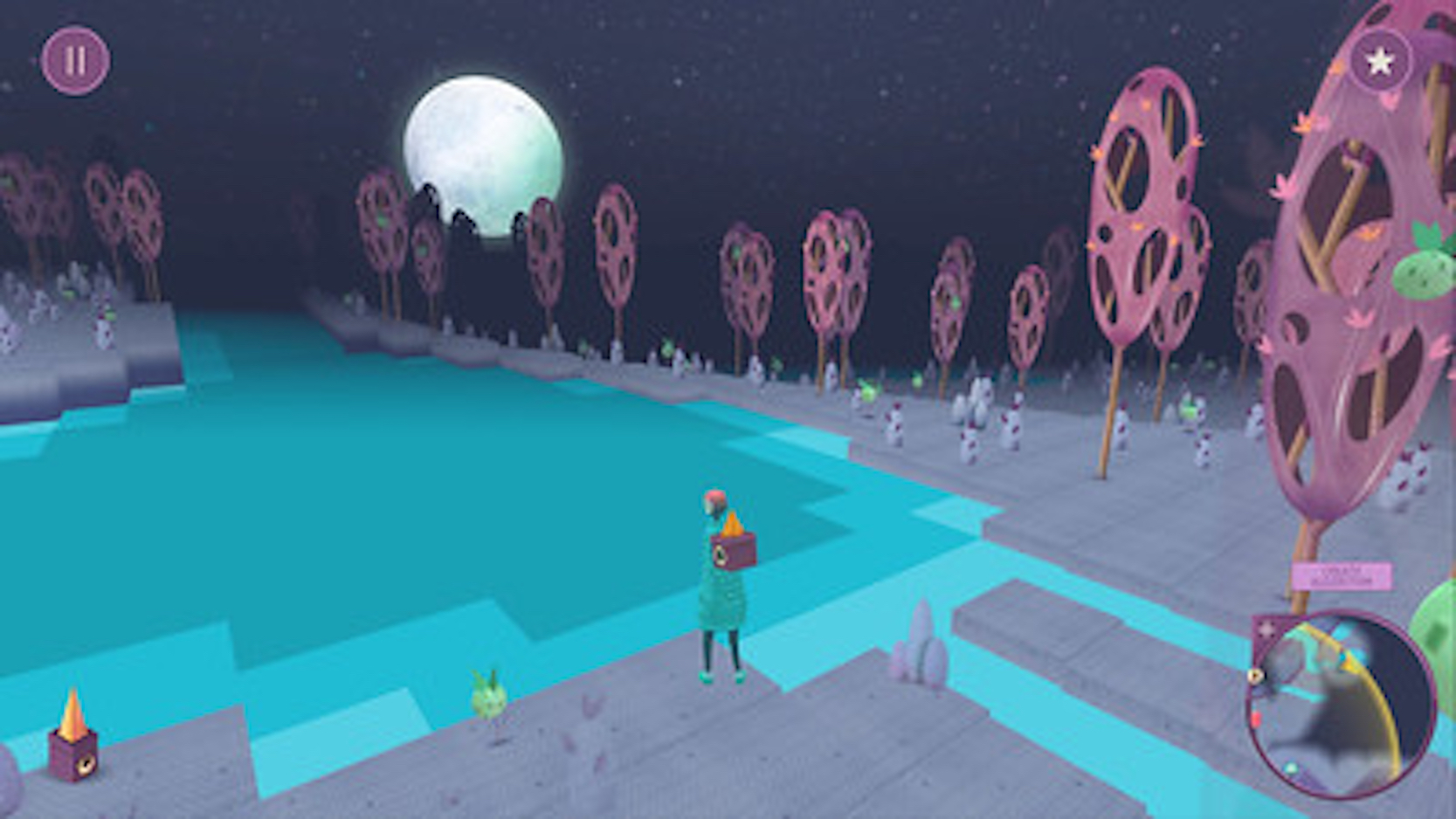
In Wanderer approaches to gameplay, evidence of CT—particularly decomposition—was observed when learners would tackle the problem of meeting and befriending creatures by breaking this process into a series of steps that included thinking about what fruit each creature needs, learning how to get the fruit, and then feeding it to the creature to make it a member of their “pack” so they could use it to solve problems.
What Decomposition in Wanderer Gameplay Sounds Like
“Some advice I’d give someone is you just have to explore a lot to find a lot of the fruit and creatures because you definitely need to collect those. And think logically, because the creatures, even though they’re super cute, they do stuff like the Digger and the Mover.” (6th-grade girl)
The Builder Approach to Play
The Builder approach involves altering the environment in various ways, usually by changing the topography of mountains, building structures to reach seeds high in the air, and digging trenches to expand water into dry areas. Builder play is motivated by the desire to shape the land to what the player wants it to be, as well as to allow the player to access other creatures that they wouldn’t be able to reach with their Avatar alone.
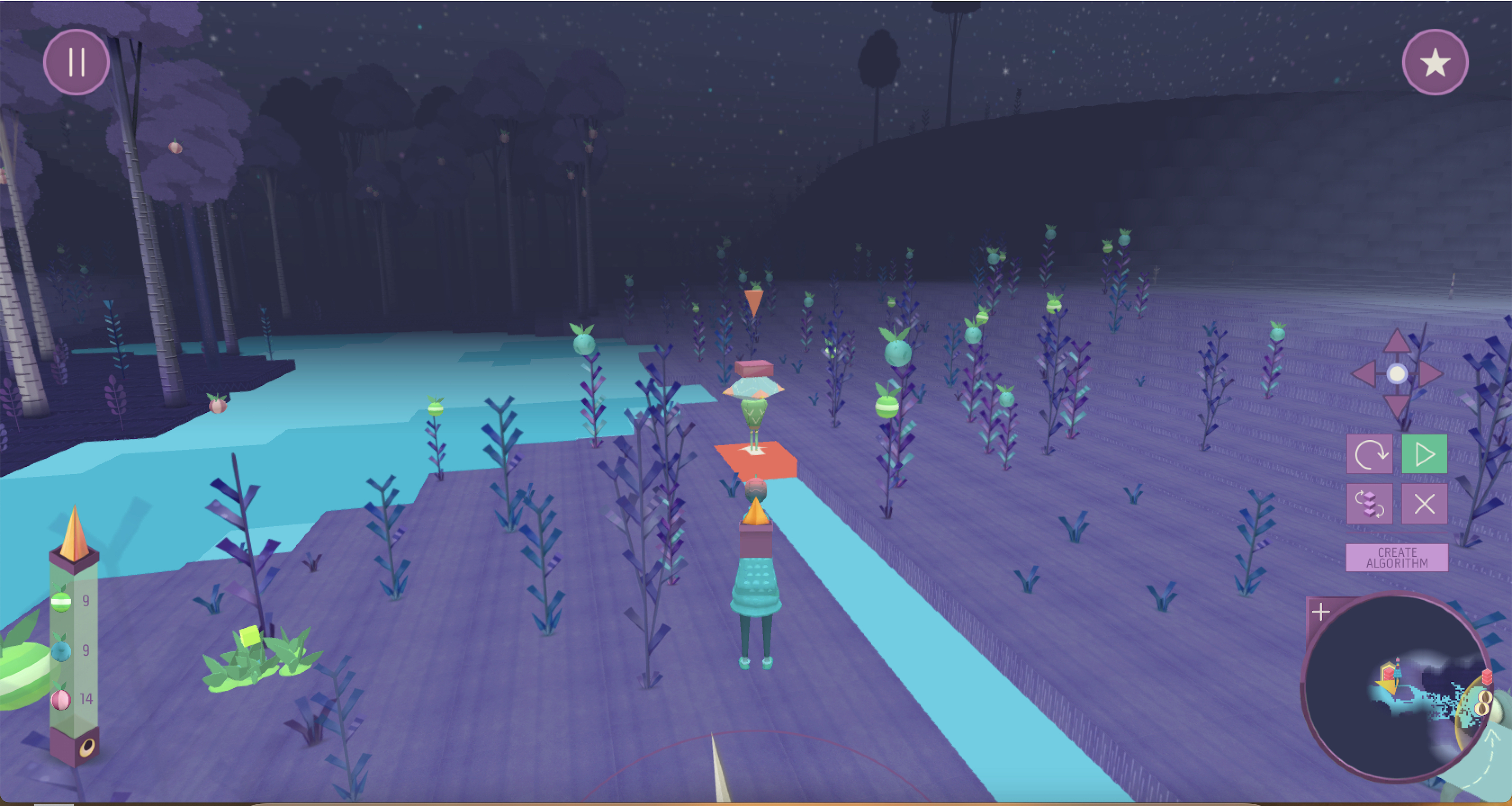
Decomposition was observed in Builder approaches to play when learners would break the problem of acquiring seeds into a series of steps: first building canals to turn dry land into fertile land where one can travel and then using available means to collect the seed.
What Decomposition in Builder Gameplay Sounds Like
“The problem on how to get this seed is that the land that seed is in is dry land. What I mean by that is if you even try to get the seed you will die because you don’t have any water. The solution is that if there is any water close to you, then you should use the digger, mover, and repeater, to get water close to you. Why this helps is because now the land won’t be that dry so you then can walk to the seed.” (5th-grade girl)
The Coder Approach to Play
The Coder approach is highly focused on learning the ins and outs of what the creatures can do so the player can use them to their full capabilities. Coders tend to experiment with creating multistep algorithms so they can quickly collect seeds and fruit that they’re out of as well as send algorithms to areas that they cannot access due to the lack of proximity to water. Coders are motivated by breaking the game, meaning that they explore the inner workings of how the game world is constructed to take advantage of the game’s mechanics to accomplish tasks.
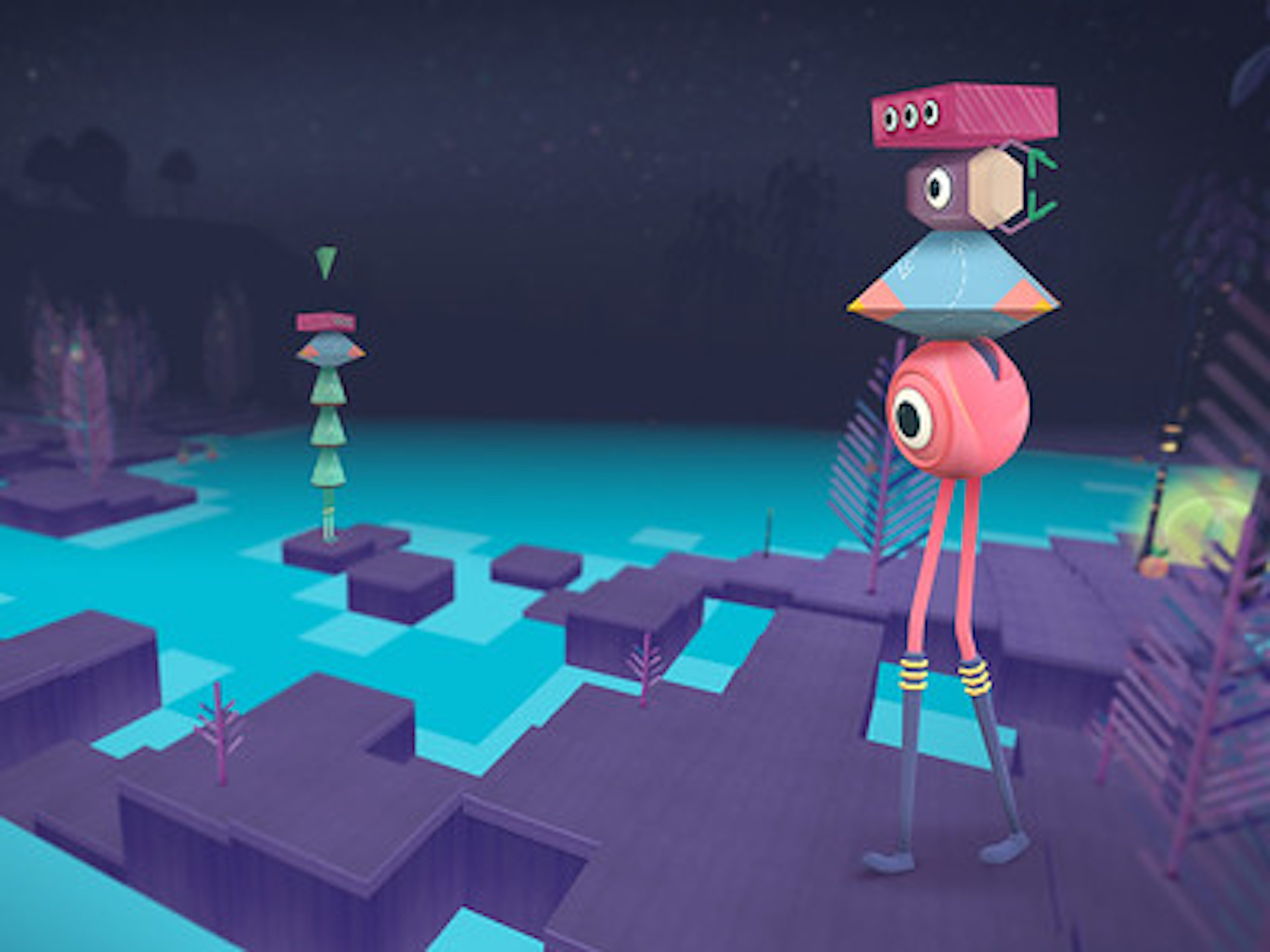
In Coder-type play, learners often applied decomposition to identify the order of needed creature functions to create an algorithm that gathers seeds as quickly as possible.
What Decomposition in Coder Gameplay Sounds Like
“So, you can put the Seeker to seek the seed. It'll seek the seed and then it’ll move to the seed with the Mover. And then you can put the Repeater, so it repeats the algorithm. But you want to repeat it infinite times because it only costs one fruit for each thing.” (6th-grade boy)
Implications for practice
Overall, all three gameplay approaches afforded opportunities for students to exhibit a broad range of key CT concepts and practices. This was especially observed when they were considering available resources to solve a problem they encountered in Algos. Regardless of style of play, it is important that teachers recognize the different ways students engage in smart decision-making, which is central to CT. Students need to:
- size up the situation or problem and consider what they can and cannot do (decomposition),
- determine a logical sequence of steps to solve the problem (algorithmic thinking),
- consider what tools they need to accomplish their intended goal and what is irrelevant (abstraction),
- consider what they have used before that would be relevant for a new problem (pattern recognition), and
- re-think what they have done in instances where they get stuck or something unexpected occurs and pull things apart to figure out what happened (debugging).
Motivation to persist in problem solving is prompted by the logic built into the game mechanics and rules, including in the achievements screen, which includes rewards for accomplishments that are characteristic of each style of gameplay. For example, the chances of attaining the “covering every biome” achievement are probably better if students like to wander about, while students are more likely to achieve “creating a 5-part algorithm” if they engage in coder play.
Teachers’ Perspectives on the Strengths and Challenges of Using the Pack to Support CT
Throughout the testing and development process, we gathered teachers’ feedback and perspectives on how they could use the Pack program to support students in developing CT habits of mind in science and CS-related classes. We also explored how teachers’ use of the game might shift their understanding of what CT involves and adjust how they support students in developing CT skills. Overall, science and computing teachers expressed both strengths and challenges in implementing the Pack in their classes to support CT.
Nearly all of the teachers we worked with recognized the strength of the Pack for offering students hands-on opportunities to experiment, test possible solutions, and learn that problems can be approached in multiple ways. Teachers also spoke of how the game afforded authentic collaborative learning opportunities, especially during the pandemic where it was difficult for students to connect in typical ways due to remote instruction. For example, teachers who taught computer science or technology classes in particular were surprised by how students spontaneously shared the algorithms and detailed strategies they used to solve problems, which students previously had difficulty doing. Teachers also valued how many CT concepts were actually embedded in the game’s logic and gameplay and how students could engage in CT through the game organically.
Teachers shared the importance of incorporating time for students to reflect on their gameplay. One teacher had a “tips and tricks” wall where students posted different strategies for solving shared problems (e.g., how to harvest seeds). Through the tips and tricks feedback, students expressed their decision-making process for approaching challenges in the game and saw the variety of ways to approach the same problem, some more efficient than others. In addition, teachers found that “dilemma” sheets created by NYSCI showcasing a typical problem scenario in the game was a fruitful tool for prompting students to reflect on their thinking and engage in discussion, regardless of their play level. General questions for students to reflect on how they approached the dilemma were particularly helpful in fostering reflection on specific CT concepts and practices, such as:
- “What is the problem I am trying to solve? What choices do I have here? What am I deciding between?” (decomposition)
- “What matters here? What doesn’t matter?” (abstraction)
- “What do I know about this situation? What tools do I need? What’s worked before?” (pattern recognition)
- “How do I do it? What steps do I take?” (algorithms)
- “What happened? Is that what I had in mind? What didn’t work? How can I fix it?” (debugging)
Some of the challenges teachers faced in integrating the game into their existing curricula were connected to the “out-of-the-box” thinking that is involved with playing a game like the Pack, especially the feature of accomplishing goals in different ways (even though this is advocated for by NGSS and CSTA teaching standards). Several teachers admitted that they didn’t have experience observing students taking alternative approaches to solving problems regularly in the context of their existing classroom lessons.
We learned through our professional development efforts that teachers benefited from guided gameplay where they could become familiar with the game mechanics and problems encountered in the game, as well as opportunities to share and compare problem-solving strategies with peers to witness how CT skills and concepts could emerge out of varied gameplay approaches. They also benefited from specific prompts for leading reflective class discussions around CT when students progressed through the games at different rates or took different gameplay approaches. While some expressed that they would like to have students progress at the same rate to address this challenge, many also recognized this wasn’t realistic as there will always be students who go far ahead and others who want to more deeply explore the game world before moving to the next level. These strategies and ideas—particularly guided gameplay and reflective discussion prompts—have become a central component of our online community of practice and professional development workshops.
Tips for Using Digital Games to Support Computational Thinking
To create quality CT learning experiences through open-world games like the Pack and others (e.g., University of Wisconsin’s Rainbow Agents and TERC’s Zoombinis), teachers across STEM disciplines need support in understanding how to draw in learners who have been historically marginalized in computer science courses and careers. We have identified key factors to consider when integrating games into instruction with the goal of fostering understanding of key CT concepts and practices.
Highlight the multiple ways students can solve the same problems in an open-world game. Games with mechanics that reward more than a single right answer and invite different approaches to solving a finite set of problems provide opportunities to engage students in all aspects of CT. But this doesn’t happen on its own. Build in time for students to compare and contrast their problem-solving strategies to foster the idea that CT involves considering different approaches, some more efficient than others. Presenting dilemmas from the game where students are invited to think about the best solution from their point of view and why it could work well proved a successful way to foster CT concepts and practices, regardless of gameplay preferences.
Be on the lookout for CT in different gameplay approaches. Especially in games designed to support coding and logical thinking, it is easy to be impressed by students who exhibit coder-type approaches to gameplay who strategize how to break the code and win the game. To ensure that games open up CT to everyone, look for and draw out CT skills in the less obvious problem-solving strategies that wanderers employ.
Build on opportunities for empathic play to promote equity and inclusion. In the case of the Pack, endearing characters who possess different powers provide inclusive and motivating entry points for non-coder types to learn about different game functions and how they can be combined to solve problems. Other games also have these opportunities, such as Minecraft and Rainbow Agents. When using digital games to promote CT, build on empathic aspects that go beyond fighting or winning, such as narratives or game mechanics focused on creating safe environments in which game world inhabitants will thrive.
Encourage reflection but don’t take students out of the gameplay. A major strength of the Pack in the classroom is the spontaneous collaboration that often occurs between different students through sharing tips for navigating the game. Documentation tools like gameplay journals and “tips and tricks” walls that invite students to share problem-solving strategies that emerge from their gameplay are useful ways to highlight some of the CT skills students are using. This kind of reasoning is needed in the science classroom and reflection offers a way to bridge to the standard-based practices that are part of good science and technology instruction.
Conclusion
With artificial intelligence, machine learning, and big data rapidly evolving and becoming integral to nearly all aspects of daily living, one of the most pressing challenges for all learners is to develop computational habits of mind that prepare them to navigate and understand complex societal challenges. This requires the ability to critically question, apply, and reimagine how technology can aid in decision-making and problem solving to benefit people’s lives. Games can be a perfect training ground for inviting all kinds of learners to develop these essential skills.
Dorothy Bennett is the Director of Creative Pedagogy, Cornelia Brunner is Developmental Psychologist and Senior Advisor, and Nicholas Hartmann is a Research and Development Assistant, all at the New York Hall of Science - Research Exhibits and Programs in Flushing, New York. Stephen Uzzo is Chief Technology Officer at the National Museum of Mathematics in New York City.
Acknowledgments
The Pack program was supported by the US Department of Education (Award No. U411C190044), the National Science Foundation (Award No. 1543144), and the JPB Foundation. Any opinions, findings, and conclusions or recommendations expressed in this material are those of the authors and do not necessarily reflect the views of the aforementioned funders.
Equity Inclusion Science and Engineering Practices Technology Elementary Middle School Informal Education


